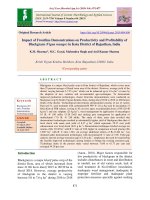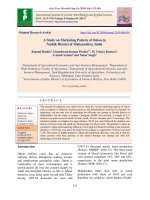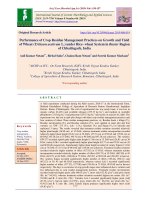Oilseeds production gaps under cluster frontline demonstration in Kohima district of Nagaland, India
Bạn đang xem bản rút gọn của tài liệu. Xem và tải ngay bản đầy đủ của tài liệu tại đây (199.21 KB, 6 trang )
Int.J.Curr.Microbiol.App.Sci (2020) 9(5): 2023-2028
International Journal of Current Microbiology and Applied Sciences
ISSN: 2319-7706 Volume 9 Number 5 (2020)
Journal homepage:
Original Research Article
/>
Oilseeds Production Gaps under Cluster Frontline Demonstration in
Kohima District of Nagaland, India
Imtisenla, Longma Yanger Pongen*, Temjennungsang, Khekali Sema,
K. Michael Pienyu, Zhiete and V. Akashe Zhimomi
Krishi Vigyan Kendra, Kohima, Nagaland-797109, India
*Corresponding author
ABSTRACT
Keywords
Cluster front line
demonstration,
Yield gap,
Extension gap,
Technology gap,
Technology index
Article Info
Accepted:
15 April 2020
Available Online:
10 May 2020
Oilseed production through Cluster Frontline demonstration is a strategy to
increase oilseeds crops under various agro climatic condition of Kohima district in
Nagaland. The study focused on horizontal dissemination of oilseed production
during Kharif and Rabi period of 2017 to 2019. It observed a wide yield gap
between achievable potential yield and demonstrated yield mainly due to
extension gap and technology gap. The maximum extension gap on average was
found in groundnut (156kg/ha), followed by sesamum (172 kg/ha) and toria (115
kg/ha). The district has the potential to increase oilseed production in groundnut
from 15.07% to 27.85%, sesamum (17.77% to 20.76%) and toria (15.38% to
22.80%), respectively. The technological index varied on average between 33.34
to 47.44%. The incremental benefit: cost ratio on average varied between 2.53 to
3.33 indicating that selection of viable improved technologies would boost oilseed
production substantially for doubling farmers’ income.
Introduction
Oilseed crop occupies and important place in
Indian Agriculture. It covers an area of 26
million hectare and produces 30 million
tonnes of oilseeds of which 72 percent
cultivated area fall under rainfed agriculture.
India also ranks fourth in terms of oilseed
production in the world. Vegetable oils which
are an essential item for homes are produced
from nine major oilseeds crops, among them
Soybean (39%), Groundnut (26%) and
Rapeseed-Mustard (24%), contribute more
than 88% of total oilseeds production in the
country.
Despite its huge production India still is the
largest importer of edible vegetables oil in the
world, followed by china and USA. (GoI.
2018-19).
2023
Int.J.Curr.Microbiol.App.Sci (2020) 9(5): 2023-2028
Oilseeds producing areas are concentrated
mainly in the central and southern parts of
India in the states of Madhya Pradesh,
Gujarat, Rajasthan, Andhra Pradesh and
Karnataka.
Oilseed crop production for oil extraction is in
a very nascent stage in kohima district of
Nagaland. The district is bestowed with
varied agro-climatic condition and soil type
that enables to grow wide varieties of oilseeds
viz. Mustard and rapeseed, sesamum, perilla,
groundnut, sunflower which constitute the
major oilseed of the district. The low
productivity could be due to hilly terrain, lack
of irrigation facilities, inferior quality seeds,
rainfed cultivation and traditional farming
system.
Therefore, to meet the demand of the growing
population of the district, as projected in the
vision 2020 document of the Krishi Vigyan
Kendra. The strategy was to increase the
acreage by 61% by year 2020 from the base
year (2006-07) and increase the productivity
from 0.88MT/ha to 1.78 MT/ha during the
same period (Anonymous, 2008).
The implementation of Cluster Frontline
Demonstration (CLFD) on oilseed in the year
2015 was a right initiative programme under
the National Food Security Mission for
boosting the oilseed production in the district.
A number of evidences pertaining to yield gap
analysis under Frontline Demonstration had
been carried out by Krishi Vigyan Kendras
(KVKs) in different foodgrains like Pulses
(Pongen, L.Y. et al., 2019), Oilseeds (Kanojia
et al., 2019) and Cereals (Mubark and
Shakoor, 2019).
Earlier studies estimated a wide productivity
gaps in different crops. The present study also
sought to assess the yield gap in oilseeds
production system as no evidence of earlier
studies is found for Kohima district, it aims
not only to increase oilseeds production but
also help improve the land and labour use
efficiency, reduce production cost, introduce
new genotypes seed varieties and doubling
farmers’ income.
Materials and Methods
The present study was carried out by Krishi
Vigyan Kendra, kohima to understand the
production gaps of oilseeds production. The
data for the cropping period of Kharif 2017&
2018 and Rabi 2017-18 & 2018-19 were
identified for the study. Oilseed promotion
during these periods covered an area of 110
ha, involving 158 farmers under 46 villages.
Cluster Front Line Demonstration (CFLD) on
Oilseed was initiated during 2015-16 under
the National Food Security Mission (NFSM)
Programme and targeted three oilseeds crops
viz. Toria (var. TS-36), Groundnut (G-2) and
Sesamum (ST-1683) with respect to
traditional local cultivar.
Before conducting the CFLD programme an
understanding of the farmers, their farming
situation, resources and rapport with them
was established. Before the demonstration
soil sampling was also collected and tested
and found to be moderately acidic in texture
with soil pH ranging from 5.5-6.0. The
available nitrogen, phosphorus and potassium
were also analyse and found to be 350-410,
12-45 and 124-156, respectively.
Estimation of yield increase over farmers
practice, technological gap, extension gap
and technological index
In Cluster Frontline Demonstration scientific
package of practices were adopted whereas in
farmers practices existing agricultural
procedure followed by the farmers were
taken.
2024
Int.J.Curr.Microbiol.App.Sci (2020) 9(5): 2023-2028
Primary data on farmers practices and crop
yields were collected. The yield increase in
demonstration over farmers’ practice was
calculated by using the following formula:
The output data were analyzed as per Samui
et al., (2000) to estimate the Technology gap,
Extension gap and Technology index with the
following equations.
Technology gap= Potential
Demonstration yield (avg)
yield
-
Extension gap= Demonstration yield (avg) Farmers yield (avg)
Results and Discussion
Grain yield
Demonstrated yield data (Table 1) revealed
that the yield of oilseed fluctuated between
the years and were invariably higher than the
farmer’s yield. On average the demonstrated
yield was highest in groundnut (894 kg/ha)
and lowest in sesamum (532.5 kg/ha) as
similar trend follows in case of farmers yield
with an average high in groundnut (738
kg/ha) and lowest for sesamum (446.5 kg/ha).
The
percentages
yield
increase
of
demonstration over farmers yield was also
observed in groundnut with highest (27.85%)
during kharif 2018 and lowest (15.07%)
during the previous year of kharif 2017, with
highest (21.46 %) average yield increase
among the oilseed crops.
The data also indicated that the yield could be
raised to 15.38 to 22.8 percent in toria (TS36), 15.07 to 27.85 percent in groundnut (G2) and 17.77 to 20.76 percent in sesamum
(ST-1683) over farmers yield by adoption of
improved oilseeds technology.
Economic analysis of the demonstration
Cost of cultivation includes all expenses for
purchase of seeds, pesticides, labour cost and
other operational charges that could have
incurred during the production process. The
farmers’ family labour was not taken into
consideration for the present study. The Gross
return and Net return were worked out
accordingly by taking cost of cultivation and
price of grain yield in each case of the oilseed
crop.
Additional cost was worked out to analyse the
overall expenditure on the improved
technology over farmers practice. Similarly
the Incremental Benefit cost ratio (IBCR) was
worked out as a ratio of additional returns and
corresponding additional costs as presented
by Vedna et al., 2007.
Yield gaps analysis
The yield under demonstrations, potential
yield and farmers yield were compared to
assess the yield gaps of the technology. The
yield gap was categorized into extension and
technology gap. Extension gap indicates the
need to motivate farmers to adopt improved
technologies over the local practices.
The maximum extension gap in groundnut
(195 kg/ha) during kharif 2018 and kharif
2017 (117 kg/ha) was observed to be the
highest with an average extension gap of 156
kg/ha, it also indicated to be the highest on
average basis among the oilseeds.
2025
Int.J.Curr.Microbiol.App.Sci (2020) 9(5): 2023-2028
The lowest extension gap average of 19.09
kg/ha was observed in toria with extension
gap of 130 kg/ha and 100 kg/ha during rabi
2018-19 and rabi 2017-18, respectively.
Technology gap was the highest in groundnut
(807kg/ha and 805kg/ha) during kharif 2017
and kharif 2018 while it was lowest in
sesamum (270 kg/ha and 265 kg/ha) during
the same growing period of kharif 2017 and
kharif 2018, on average the highest
technology gap was observed in groundnut
(806 kg/ha) followed by toria (475 kg/ha)
while the lowest gap was indicated in
sesamum (267.5 kg/ha).
The observed technology gap was mainly due
to soil nutrient status differences, rainfed
condition and hilly terrain prevailing in the
district. Though potential yield of a crop in
normal locale condition is difficult to be
achieved yet, the technology gap can be
minimized only if better performing varieties
are available.
Therefore, it is suggested the need of better
performing genotypes for improving the
productivity of higher altitudes. Similar
suggestion had also been proposed in earlier
studies by Bhatia et al., (2006), Bhartiya et
al., (2017).
Although, demonstration are conducted under
strict supervision of the scientist, technology
gap appears which may be attributed mainly
due to lack of irrigation facilities, variation in
soil fertility status, non-congenial weather
conditions and local specific management
problems faced for the attainment of potential
and demonstration yields (Kanojia et al.,
2019).
Technology index
Technology index indicates the feasibility of
the evolved technology in the farmers’ field.
Lower the value of technology index, higher
is the feasibility of the improved technology
(Balai et al., 2013). Technology index during
the period of study on average basis varied
from 33.43 percent to 47.41 Percent.
The lowest technology index was recorded in
sesamum var. ST-1683 (33.12%) during
kharif 2017 while highest value of 47.47 %
was observed in groundnut var. G-2 during
kharif 2017.
Technology index was higher in groundnut
(47.35 to 47.47 %.) as compared to toria (37.5
to 41.6%) and sesamum (33.12 to 33.75%).
This indicates that a wide gap existed before
the technology evolved and technology
adoption at the farmers’ field.
Economic analysis
The Economic analysis (Table 2) of Gross
and Net returns on average basis was
observed to be highest (Rs. 43806/ha & Rs.
24946/ha) in groundnut var.G-2 under
demonstration as well as the farmers’ yield
(Rs. 36162/ha & Rs. 19127/ha).
Similar, trend on average basis was also
followed in terms of lowest Gross and Net
returns as it was observed under
demonstration (Rs. 25440/ha & Rs. 11440/ha)
and farmers yield (Rs. 21600/ha & Rs.
8500/ha) in case of sesamum.
The additional cost of production of improved
technology on average basis varied between
Rs.950/ha and Rs.1825/ha with the highest
expenditure in groundnut, followed by toria
(Rs. 1350/ha) and lowest in sesamum.
The additional return on average also
followed a similar trend with maximum return
of Rs.5819/ha in case of groundnut, followed
by toria (Rs.3430/ha) and lowest return of Rs.
3178/ha in sesamum.
2026
Int.J.Curr.Microbiol.App.Sci (2020) 9(5): 2023-2028
Table.1 Technology gap, Extension gap and Technology index in oilseed production under Kohima District
Crop/
variety
Season/
year
Area
(ha)
No. of
farmers
No. of
villages
Yield (kg/ha)
PY*
DY*
FY*
Increase
in yield
(%)
Gap analysis (kg/ha)
Extension gap
Technology
gap
Technology
Index
(%)
Toria
20
38
7
TS-36 Rabi 2017-18
10
25
5
TS-36 Rabi 2018-19
Average
15
31.5
6
Groundnut
20
23
6
G-2 Kharif 2017
20
33
11
G-2 Kharif 2018
Average
20
28
8.5
Sesamum
20
19
8
ST-1683 Kharif 2017
20
20
9
ST-1683 Kharif 2018
Average
20
19.5
8.5
*PY-Potential Yield, DY-Demonstration Yield, FY-Farmers Yield
1200
1200
1200
750
700
725
650
570
610
15.38
22.80
19.09
100
130
115
450
500
475
37.5
41.6
39.55
1700
1700
1700
893
895
894
776
700
738
15.07
27.85
21.46
117
195
156
807
805
806
47.47
47.35
47.41
800
800
800
535
530
532.5
443
450
446.5
20.76
17.77
19.26
92
80
172
265
270
267.5
33.12
33.75
33.43
Table.2 Economic analysis of CFLD in oilseed production under Kohima District
Crop/
variety
Season/
year
Cost of cultivation
(Rs/ha)
DY
FY
Gross return
(Rs/ha)
DY
FY
Net Return
(Rs/ha)
DY
FY
Additional cost
(Rs/ha)
Additional
return
(Rs/ha)
IBCR*
Toria
TS-36
Rabi 2017-18
14150
12950
30750
26650
16600
13700
1200
2900
2.42
TS-36
Rabi 2018-19
14750
13250
29400
23940
14650
10690
1500
3960
2.64
14450
13100
30075
25295
15625
12195
1350
3430
2.53
Kharif 2017
18860
17500
43757
38024
24897
20524
1360
4373
3.21
Kharif 2018
18860
16570
43855
34300
24995
17730
2290
7265
3.17
18860
17035
43806
36162
24946
19127
1825
5819
3.19
14050
14000
13050
13100
25680
25440
21264
21600
11630
11440
8214
8500
1000
900
3416
2940
3.41
3.26
Average
14025
*IBCR- Incremental Benefit Cost Ratio
13075
25560
21432
11535
8357
950
3178
3.33
Average
Groundnut
G-2
G-2
Average
Sesamum
ST-1683
ST-1683
Kharif 2017
Kharif 2018
2027
Int.J.Curr.Microbiol.App.Sci (2020) 9(5): 2023-2028
Incremental Benefit Cost Ratio (IBCR) on
average also varied between 2.53 and 3.33
among the different oilseed crops. The highest
IBCR of 3.41 and 3.26 was recorded in case of
sesamum (ST-1683) during both the years
followed by groundnut (3.21) during kharif
2017. The lowest IBCR of 2.42 was recorded in
case of toria var. TS-36 during Rabi 2017-18.
From the data collected during the study period,
it was found that exist a wide gap between
potential and demonstration yield mainly due to
Technology and Extension gap.
It can also be concluded that the oilseed
productivity can be improved by adopting the
improved Technologies by changing the
farmers’ attitude towards newer technology and
willingness to try new production techniques.
Acknowledgement
We are thankful to Director ATARI, NER
Zone-VII, umiam Meghalaya for sponsoring the
project under NFSM Oilseed programme and
also those beneficiaries who devoted their time
and energy for the purpose of technology
demonstration and adoption.
References
Anonymous (2008)- Vision 2020: Krishi Vigyan
Kendra, Nagaland. pp 95. GoI, Annual
Report (2018-19), Deptt. of Agriculture,
Cooperation & Farmers Welfare, New
Delhi.
Balai C.M., Jalwania R., Verma L.N., Bairwa
R.K. and Regar P.C. (2013) Economic
impact of front line demonstrations on
vegetables in tribal belt of Rajasthan. Curr.
Agri. Res. 1(2): 69-77.
Bhartiya. A, N. Chandra, R.S. Pal, J.P. Aditya and
Jyoti Bajeli. (2017). Comparative yield
gaps, economic impact and constraint
analysis in front line demonstrations of
soybean and black soybean in Uttarakhand
hills. Indian J. Agric. Res. 51(5): 483-487
Bhatia V.S., Singh P., Wani S.P, Kesava Rao A.
V. R and Srinivas K.(2006). Gap analysis
of soybean, groundnut, pugeon pea and
chicj pea in India using simulation
modeling. Global theme on Agroecosystems
Report. International crops Research
Institute for Semi-arid Tropics (ICRISAT):
(156)
Kanojia Yogesh, singh harish Chandra and
Damor, R.K. (2019). Yield gap analysis of
soybean through Frontline demonstration in
pratapgarh: A tribal district of Rajasthan,
India. Int. Jn Curr. Microbial App. Sci. 8
(04): 1020-1023.
Mubark. T and Shakoor, A. (2019) Impact
Assessment of Technological Interventions
for Reducing Yield Gaps in Rice (Oryza
sativa L.) Under Temperate Hill Ecology.
Journal of Krishi Vigyan 7 (2) : 140-143
Pongen. L.Y., Imtisenla and Zhimomi V. A.
(2019) Impact Assessment in Yield Gaps of
Cluster Front Line Demonstration under
Pulse Production in Kohima District.
International Journal of Agriculture
Sciences, 11(15): 8883-8884.
Samui S.K., Maitra S., Roy D.K., Mandal A.K.
and Saha D. (2000) Evaluation of front line
demonstration on groundnut. J. Indian Soc
.Coastal Agric. Res. 18(2): 180-183.
Vedna, Kumari, Kumar, A., Kumar, A. and
Bhateria, S. (2007) Demonstration - an
effective tool for increasing the productivity
of rapeseed- mustard in Kangra district of
Himachal Pradesh. Himachal Journal of
Agricultural Research 33(2): 257-261.
How to cite this article:
Imtisenla, Longma Yanger Pongen, Temjennungsang, Khekali Sema, K. Michael Pienyu, Zhiete and
Akashe Zhimomi, V. 2020. Oilseeds Production Gaps under Cluster Frontline Demonstration in Kohima
District of Nagaland, India. Int.J.Curr.Microbiol.App.Sci. 9(05): 2023-2028.
doi: />
2028









